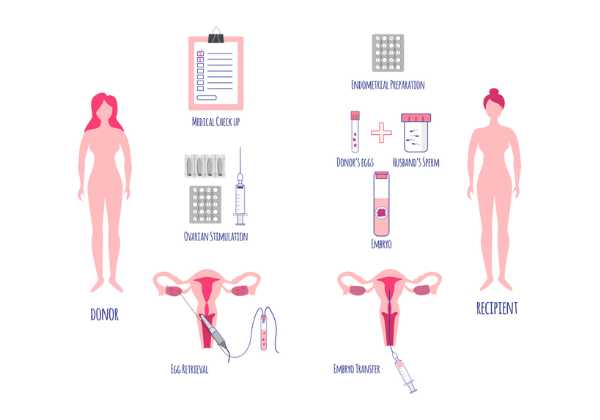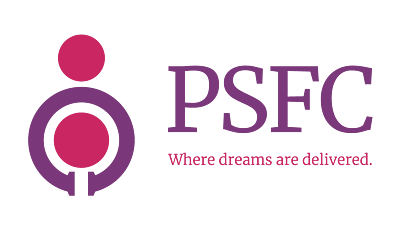EGG (OOCYTE) DONATION
HISTORY:
The first baby born due to oocyte donation was done three years after the first IVF baby was born. Initially, oocyte donation was intended for women who experience premature menopause; gradually, the procedure became a solution for older women.
WHEN IS EGG DONATION NEEDED?
There are four main reasons people choose oocyte (egg) donation as a means of having a baby:
- Several failed attempts at IVF or recurrent miscarriages caused by poor egg quality or poor embryo development.
- Premature menopause or other factors are causing cessation of egg production, such as hereditary diseases, endometriosis, surgery done on the ovaries resulting in significant loss of ovarian tissue.
- Infertile couples where the woman is not permitted to use drugs necessary to induce oocyte production.
- Older women who have entered menopause. Arguments against oocyte donation usually focus on these types of patients. A 65-year-old Romanian woman is the oldest woman recorded to have a baby through this method.

In Oocyte (egg) donation, the baby that is born carries half of the genetic make-up of the family. Also, the parents experience the psychosocial changes resulting from sharing the pregnancy and delivery. The source of the donor egg is usually at an age where chances of chromosomal anomalies are very low. However, the age of the donor does not protect the mother from complications during her pregnancy. The age of the woman carrying the baby and her overall health affects how the pregnancy will progress. Even if ovaries stop egg production, the uterus retains its capability to carry a baby to term. The uterus can be reprogrammed with oral or injectable drugs to prepare the organ for implantation and pregnancy. Chances of pregnancy are similar to a younger woman using her eggs. Sometimes pregnancy rates can even be higher for these women.
HOW TO CHOOSE THE OOCYTE?
We operate with recognized and registered Donor Oocyte banks. Donors will be selected according to the criteria listed below and will be strictly confidential. Before a woman is accepted in the donor oocyte program, she will be examined by the Bank’s gynaecologist, a genetic and, if necessary, a thorough psychological evaluation will be done on the prospective donor. The recipient will be privy to the donor’s age, physical health and education status. Any information revealing the donor’s identity will be confidential under a code name that only the hospital administrators can access. Likewise, the recipient’s identity is also kept confidential. We follow ART 2022 guidelines issued by Govt of India, Ministry of Health in this regard.
- Must be between the ages of 20 and 32
- Should not have any marked physical characteristics such as an unusual noise that might distinguish her.
- Donors are selected according to the recipient’s race, colour and blood type ,donor’s intelligence level should be average or above average
- Must not have any physical restrictions against procedures such as controlled ovarian hyperstimulation and egg collection
- A person who has known genetic diseases in the family or has lost a baby for unexplained reasons cannot be accepted in the program as a donor.
Egg collection does not reduce the oocytes available to the woman. The procedure does not affect the donor’s fertility and age of menopause onset. Her chances of achieving pregnancy will be no different after she donates her eggs.
Briefly, the donor goes through two main steps. The first prepares the ovaries to stimulate increased egg production, and the second is collecting those eggs that develop. The woman will start the drug regimen on the second or third day of menstruation. The eggs will be collected after approximately 8-12 days of stimulation. Egg collection marks the end of the donor’s role in the process. Her eggs will be inseminated by the sperm obtained from the recipient’s husband, and the resulting embryos will be transferred to the recipient’s uterus.
Preparation of the recipient
If the recipient menstruates regularly, there are two methods to prepare her uterus. Either the recipient’s cycle is synchronised to that of the donor by using a combination of hormonal supplements, or they temporarily suppress the recipient’s ovulation. Doctors usually use GnRH analogue drug type for this purpose. After the woman has her period, she starts taking estrogen hormone orally; later, Progesterone is added on the day the eggs are collected. This way, the endometrium (uterine lining) acquires the necessary thickness for the embryo to implant.
Preliminary tests done before the procedure are summarised below.
- A mock transfer with the same type of catheter used to transfer the embryos. Menopausal women, in particular, may have a narrow or deformed cervix. The cervix can be dilated under anaesthesia if necessary.
- Gynecological ultrasonography
- A pelvic exam where the doctor may take a pap smear or order a colposcopy for a more detailed examination.
- Hysteroscopy (if the clinician cannot get a clear view of the uterine lining through ultrasonography)
- Preparation of the endometrium (the uterine lining that is shed every month) using drugs. For a successful pregnancy to occur, the recipient’s endometrial thickness should reach at least 8mm.
Our centre may run the following tests on the recipient couple:
For Recipient

Blood type

Panel of pre-pregnancy blood tests

Hepatitis B, C

HIV (AIDS)

Hemoglobin electrophoresis

Mycoplasma

Chlamydia

CMV

Toxoplasmosis

Syphilis

Herpes

Rubella
For Recipient Partner

Blood type

Panel of pre-pregnancy blood tests

Hepatitis B, C

HIV (AIDS)

Hemoglobin electrophoresis

Sperm count

Syphilis

Cystic Fibrosis

Y Chromosome microdeletion test


